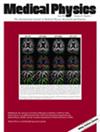Breast cancer detection from ultrasound computed tomography imaging using radiomic analysis: in silico trial
Abstract
Background
Ultrasound computed tomography (USCT) is an imaging modality currently under development for its clinical use in breast imaging. In order to justify clinical trials on imaging prototypes, further research is required to investigate uses and limitations of USCT.
Purpose
We investigate the potential of USCT for the detection of breast lesions through the computerized analysis of speed-of-sound (SOS) images of the breast.
Methods
We conducted an in silico study with a set of 116 virtual breast phantoms (VBPs). We simulated US acquisition and reconstructed 2D SOS slices of the breast via the full waveform inversion (FWI) technique. Subsequently, we conducted breast lesion detection based on computerized texture features (i.e., radiomic features) of the SOS slices. We compare the performance in cancer detection against radiomic analysis of mammograms in terms of the area under the curve (AUC) of the receiver operating characteristic (ROC) curve with 95% confidence intervals estimated using five-fold cross-validation. Statistical analysis involved the Wilcoxon rank-sum test to evaluate significant differences in detection scores, with a significance level of . AUCs were compared using DeLong's test, and the significance level was adjusted with Bonferroni's correction to account for multiple comparisons.
Results
The AUC for lesion detection from reconstructed SOS images and mammography were 0.87 (95% CI: 0.81-0.94) and 0.77 (95% CI: 0.68-0.86), respectively. Detection of breast lesions using the multimodal approach combining SOS images and mammograms, yielded an AUC of 0.89 (95% CI: 0.83-0.95), with statistically significant differences with respect to the use of mammograms alone (p = 0.0112).
Conclusions
Our in silico experimental results demonstrate the feasibility of using USCT for breast lesion detection using fully automatic analysis of reconstructed SOS images. The multimodal approach, that combines radio-density and acoustic properties of the breast, outperforms the analysis using a single modality.

 求助内容:
求助内容: 应助结果提醒方式:
应助结果提醒方式:


